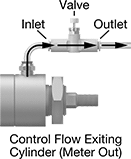Matching Flow Diagrams to Replace an Air Directional Control Valve
More
Choosing an Air Directional Control Valve
More
About Pressure-Relief Valves
More
About Flow Control Valves
Also known as cylinder speed controls, flow control valves let you control the extension or retraction speed of your air cylinder. They regulate airflow as it passes from the valve's inlet to its outlet. Air flows freely in the opposite direction.
More
Compact Pressure-Relief Valves
Due to their small size, these valves are often installed on tanks in low-clearance areas. They begin opening at the set pressure. Nylon valves fully open at about 10% over the set pressure and steel valves fully open at about 50% over the set pressure. Valves begin closing as pressure drops and fully close when the system pressure is restored below the set pressure. All have a vent outlet to exhaust discharge directly. Set pressure is not adjustable.
Air-Exhaust Flow Control Valves


Install these valves in the exhaust ports of air directional control valves to control exhaust air speed without needing access to your cylinder. They control flow in one direction as air moves from the inlet to the exhaust port (meter out). Air flows freely in the opposite direction. Valves exhaust to the atmosphere and include a muffler to reduce the exhaust noise.
Flow coefficient (Cv) is a measurement that indicates how much airflow can pass through a valve. When selecting between valves with the same port size, choose the valve with the higher flow coefficient to ensure it provides enough airflow to operate your system.


























